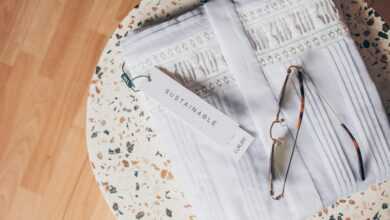
Fabric 101 For Blokes: When To Choose Wool, Twill, Oxford, Poplin & Flannel
Let’s cut to the chase: if you know your fabrics, getting dressed gets miles easier. Wool, twill, Oxford, poplin and flannel each have a job to do. Pick the right one and you’ll look sharp and feel comfortable. Pick the wrong one and, well… it’s like wearing a picnic blanket to a board meeting. So, here’s what matters—and when to choose what.
Quick Cheat Sheet (save this)
| Fabric | Best For | Season | Feel & Look | Why Choose It |
|---|---|---|---|---|
| Wool | Suits, overcoats, smart trousers, knitwear | Autumn–winter (and cool spring) | Warm, breathable, slightly textured; drapes well | Naturally regulates temperature, resists creasing, looks premium |
| Twill | Chinos, denim, workwear shirts, blazers | All year | Diagonal weave, durable, softens with wear | Tough, hides marks, hangs nicely—ideal for everyday |
| Oxford | Smart-casual shirts (button-downs) | All year (ace in spring/summer) | Chunkier basket weave, slightly grainy | Easygoing, holds shape, works with jeans and tailoring |
| Poplin | Formal shirts, summer shirts | Spring–summer | Smooth, crisp, lightweight, minimal texture | Clean look under a suit, cool and breathable |
| Flannel | Winter shirts, trousers, suits, overshirts | Autumn–winter | Soft, brushed surface, cosy | Warmth without bulk, relaxed but refined |
When to choose wool
Think cool days, sharp tailoring, and “I’ve got my life together” energy. Wool suits and overcoats give you structure without feeling stiff. It breathes, it insulates, and it bounces back from creases better than most. Heading to a winter wedding or an important meeting? Wool’s your wingman.
- Pick it for: Suits, tailored trousers, overcoats, merino jumpers.
- Avoid if: You’re in a heatwave or want a super-smooth shirt—wool’s not your shirt base layer.
- Pro tip: Look for “worsted” wool for a smoother, dressier finish; “woollen” for softer, fuzzier warmth.
When to choose twill
Ever noticed that faint diagonal line on chinos or denim? That’s twill. It’s strong, comfy, and shrugs off a busy day. If you want trousers that work Monday to Sunday—commute, pub, park—twill has your back.
- Pick it for: Chinos, denim, unstructured blazers, hard-wearing shirts.
- Avoid if: You need a razor-sharp, ultra-sleek look under a formal suit jacket.
- Pro tip: Mid-weight cotton twill chinos are the wardrobe backbone—go navy, stone, and olive to cover 90% of outfits.
When to choose Oxford
Oxford shirts are the mate who gets on with everyone. Dressed up with a blazer? Great. Thrown over a tee at the weekend? Still great. The basket weave gives it a bit of texture, so it feels relaxed but still tidy.
- Pick it for: Smart-casual shirts, especially button-down collars.
- Avoid if: You need a sleek boardroom shirt—Oxford can look a touch casual.
- Pro tip: White and light blue Oxfords will see the most mileage. Roll the sleeves and you’re instantly weekend-ready.
When to choose poplin
Poplin is your crisp, clean, “I mean business” shirt fabric. It’s smooth, cool, and sits nicely under a suit jacket without bunching. Hot day? Poplin helps you keep your cool.
- Pick it for: Formal shirts, summer office days, weddings.
- Avoid if: You want texture or need a bit more warmth.
- Pro tip: If you run warm, poplin beats heavier weaves under a blazer—less bulk, cleaner lines.
When to choose flannel
Want that cosy, “by the fire” vibe without dressing like a lumberjack? Flannel’s the move. Brushed for softness, it traps warmth and looks effortlessly relaxed. Flannel trousers and suits also exist—and they’re seriously underrated for winter smartwear.
- Pick it for: Winter shirts, overshirts, trousers, casual suits.
- Avoid if: It’s warm out—you’ll overheat fast.
- Pro tip: Grey flannel trousers with white trainers and a knit—simple, stylish, very British autumn.
How to choose by season (simple rules)
- Summer (May–Aug): Poplin shirts, Oxford if you want texture, lightweight cotton twill chinos.
- Transitional (Mar–Apr, Sep–Oct): Oxford shirts, twill chinos, unstructured cotton or lightweight wool jackets.
- Winter (Nov–Feb): Wool suits, flannel shirts/trousers, heavier twill, merino layers.
How to choose by occasion
- Office formal: Wool suit + poplin shirt.
- Smart-casual Friday: Oxford shirt + twill chinos.
- Weekend pub/coffee: Oxford or flannel overshirt + tee + twill chinos or denim.
- Winter event: Flannel suit or wool suit; merino knit under a jacket if it’s icy.
Feel tests you can do in 5 seconds
- Texture: Smooth and crisp = poplin. Slight grain = Oxford. Fuzzy/soft = flannel. Springy with drape = wool. Diagonal lines = twill.
- Crease test: Wool resists creases; poplin creases fastest; twill and Oxford sit in the middle; flannel hides creases with its soft surface.
- Light test: Hold to light. If you can see right through it, it’s likely poplin or a very light Oxford—great for warm days.
Care basics (keep it easy)
- Wool: Steam rather than iron; brush and air between wears; dry clean sparingly.
- Twill (cotton): Wash cool, air dry to avoid stiffness; a quick iron or steam does the trick.
- Oxford: Wash cool, hang to dry; slight wrinkles suit the casual vibe.
- Poplin: Wash cool, iron while slightly damp for that crisp look.
- Flannel: Gentle wash, low heat; too much tumble dries out the softness.
Common mistakes (and easy fixes)
- Wearing poplin in winter without layers: You’ll feel chilly. Add a merino knit or switch to Oxford/flannel.
- Buying a flannel shirt that’s too thick: You’ll cook indoors. Mid-weight flannel is more versatile.
- Only owning one type of shirt: Mix Oxford (smart-casual) and poplin (formal) to cover more outfits.
- Neglecting trouser fabrics: Flannel trousers in winter and cotton twill chinos year-round will upgrade your rotation.
Outfit formulas that just work
- Clean office: Navy wool suit + white poplin shirt + black oxfords.
- Smart-casual: Light blue Oxford + navy twill chinos + white trainers.
- Weekend layers: Grey tee + flannel overshirt + ecru twill jeans.
- Cold commute: Charcoal wool overcoat + knit + dark denim/twill chinos.
FAQ
Is Oxford more casual than poplin?
Yes. Oxford has texture and a chunkier weave, which reads more relaxed. Poplin is smooth and crisp for formal settings.
Can I wear flannel to the office?
Absolutely—especially in winter. Try grey flannel trousers with a merino crew and smart shoes, or a flannel suit for a softer tailored look.
Is twill only for chinos and jeans?
Nope. Twill also shows up in casual blazers and shirts. It’s a structure-and-durability play, not just trousers.
Does wool itch?
Modern merino and quality worsted wool are generally comfortable. If you’re sensitive, wear a cotton layer underneath.
Simple capsule checklist (add these first)
- White poplin shirt (formal anchor)
- Light blue Oxford button-down (smart-casual hero)
- Navy cotton twill chinos (daily driver)
- Grey flannel trousers (winter upgrade)
- Navy or charcoal wool suit (year-round formal)
- Flannel overshirt (weekend/winter layering)
Visual suggestions (for your post)
- Flat lay: Oxford vs poplin shirts side-by-side, collars visible. Alt: “Oxford vs poplin shirt comparison flat lay.”
- Close-up macro: Diagonal twill weave on chinos. Alt: “Close-up of cotton twill diagonal weave.”
- Fabric swatches grid: Wool, twill, Oxford, poplin, flannel labelled. Alt: “Fabric swatches—wool, twill, Oxford, poplin, flannel.”
- Outfit shot: Grey flannel trousers with knit and trainers. Alt: “Men’s outfit with grey flannel trousers and knit jumper.”
So, that’s the play: poplin for polish, Oxford for easy smart-casual, twill for everyday graft, flannel for winter comfort, and wool when you want sharp and warm. What’s your next step—swapping in a couple of shirts or upgrading your winter trousers?




